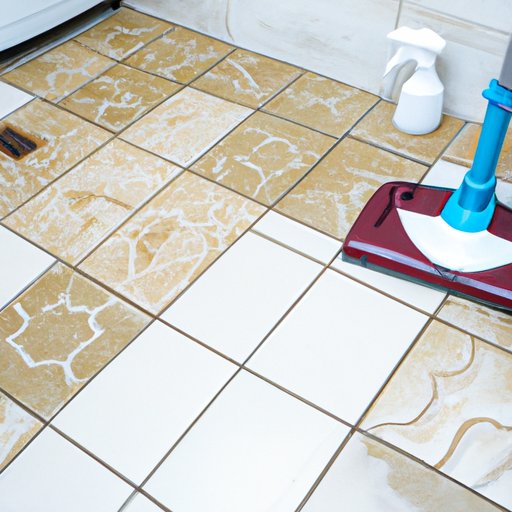Introduction
Having unclean kitchen floor tiles can be an eyesore, as well as a health hazard. Not only do dirty kitchen tiles look bad, but they can also be a breeding ground for germs and bacteria. Fortunately, cleaning kitchen floor tiles is not as difficult as it might seem. In this article, we’ll explain how to clean kitchen floor tiles in a few simple steps.
Use a Damp Mop to Clean the Kitchen Floor Tiles
Using a damp mop is one of the most effective ways to clean kitchen floor tiles. The benefits of using a damp mop include: it won’t scratch the tiles; it won’t leave behind any streaks; and it will pick up dirt and debris without leaving behind residue. Here are the steps for using a damp mop:
- Fill a bucket with warm water.
- Add a few drops of dish soap to the water.
- Dip the mop into the soapy water and wring it out until it’s just damp.
- Mop the kitchen floor tiles in a back-and-forth motion.
- Rinse the mop in the bucket of soapy water and wring it out again.
- Repeat the process until all of the tiles have been cleaned.

Vacuum Up Dirt and Debris from the Tiles
Vacuuming up dirt and debris is another effective way to clean kitchen floor tiles. The benefits of vacuuming include: it removes dirt and debris that a mop can’t reach; it prevents dust and dirt from becoming embedded in the grout; and it helps prevent staining. Here are the steps for vacuuming:
- Attach a soft-bristle brush attachment to the vacuum cleaner.
- Vacuum the kitchen floor tiles in a back-and-forth motion.
- Move the vacuum slowly to ensure that all of the dirt and debris are picked up.
- Empty the vacuum cleaner’s dustbin after each use.
Apply a Mild Detergent Solution to the Tiles, Then Scrub Them with a Brush or Sponge
Applying a mild detergent solution to the tiles and scrubbing them with a brush or sponge is another effective way to clean kitchen floor tiles. The benefits of using a mild detergent solution include: it can remove stubborn stains; it can break down grease and grime; and it leaves behind a sparkling finish. Here are the steps for using a mild detergent solution:
- Mix a few drops of mild detergent with warm water in a bucket.
- Dip a brush or sponge into the solution and scrub the tiles in a circular motion.
- Rinse the tiles with clean water and dry with a soft cloth.
- Repeat the process if necessary.

Rinse the Tiles with Warm Water and Dry with a Soft Cloth
Rinsing the tiles with warm water and drying them with a soft cloth is another important step in the process of cleaning kitchen floor tiles. The benefits of rinsing and drying include: it removes any residue left behind by the detergent solution; it prevents streaks; and it leaves behind a shine. Here are the steps for rinsing and drying:
- Fill a bucket with warm water.
- Dip a soft cloth into the water and wring it out until it’s just damp.
- Wipe the tiles in a back-and-forth motion to remove any residue.
- Dry the tiles with a clean, dry cloth.

Seal the Tiles with a Tile Sealer to Protect Them from Staining
Sealing the tiles with a tile sealer is the final step in the process of cleaning kitchen floor tiles. The benefits of sealing include: it protects the tiles from staining; it makes the tiles easier to clean; and it helps prevent odors. Here are the steps for sealing:
- Purchase a high-quality tile sealer.
- Follow the manufacturer’s instructions for applying the sealer.
- Allow the sealer to dry completely before walking on the tiles.
Conclusion
Cleaning kitchen floor tiles is not as difficult as it may seem. By following the steps outlined in this article, you can easily and effectively clean your kitchen floor tiles. The steps include using a damp mop, vacuuming up dirt and debris, applying a mild detergent solution, rinsing the tiles with warm water, and sealing the tiles with a tile sealer. By taking the time to properly clean your kitchen floor tiles, you can enjoy a spotless kitchen and a healthier home.


